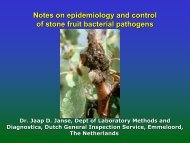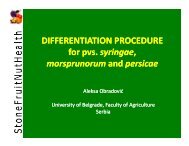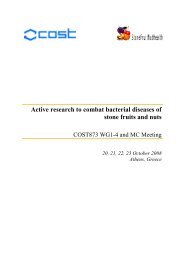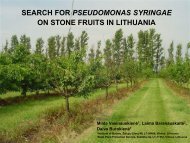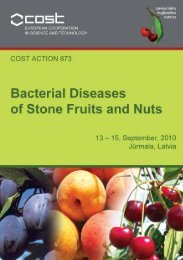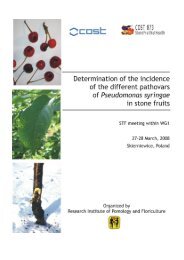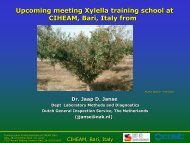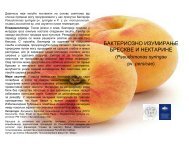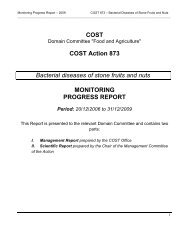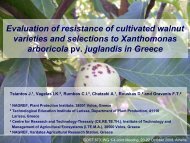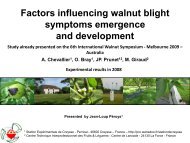Rapid and specific identification of four Agrobacterium ... - Cost 873
Rapid and specific identification of four Agrobacterium ... - Cost 873
Rapid and specific identification of four Agrobacterium ... - Cost 873
Create successful ePaper yourself
Turn your PDF publications into a flip-book with our unique Google optimized e-Paper software.
478ARTICLE IN PRESSJ. Pu"awska et al. / Systematic <strong>and</strong> Applied Microbiology 29 (2006) 470–479providing bacterial strains. J. Pu"awska is deeply indebtedto the Foundation for Polish Science for NationalScholarship for Young Scientist (Edition 2001/2002).A. Willems is grateful to the Fund for ScientificResearch – Fl<strong>and</strong>ers for a postdoctoral research fellowship.This work was supported by Polish Scientific Committee(KBN) Grant 5P06A02119.References[1] J. Brosius, T.J. Dull, D.D. Sleeter, H.F. Noller, Geneorganization <strong>and</strong> primary structure <strong>of</strong> a ribosomal RNAoperon from Escherichia coli, J. Mol. Biol. 148 (1981)107–127.[2] J. Cubero, M.M. Lopez, An efficient microtiter system todetermine <strong>Agrobacterium</strong> biovar, Eur. J. Plant Pathol. 107(2001) 757–760.[3] P. de Lajudie, E. Laurent-Fulele, A. Willems, U. Torck,R. Coopman, M.D. Collins, K. Kersters, B. Dreyfus, M.Gillis, Allorhizobium undicola gen. nov., sp. nov., nitrogen-fixingbacteria that efficiently nodulate Neptunianatans in Senegal, Int. J. Syst. Bacteriol. 48 (1998)1277–1290.[4] P. de Lajudie, A. Willems, B. Pot, D. Dewettinck,G. Maestrojuan, M. Neyra, M.D. Collins, B. Dreyfus,K. Kersters, M. Gillis, Polyphasic taxonomy <strong>of</strong> rhizobia:emendation <strong>of</strong> the genus Sinorhizobium <strong>and</strong> description <strong>of</strong>Sinorhizobium meliloti comb. nov., Sinorhizobium sahelisp. nov., <strong>and</strong> Sinorhizobium teranga sp. nov., Int. J. Syst.Bacteriol. 44 (1994) 715–733.[5] J. De Ley, R. Tijtgat, J. De Smedt, M. Michiels,Thermal stability <strong>of</strong> DNA:DNA hybrids within thegenus <strong>Agrobacterium</strong>, J. Gen. Microbiol. 78 (1973)241–252.[6] X. Dong, G. Cheng, W. Jian, Simultaneous <strong>identification</strong><strong>of</strong> five Bifidobacterium species isolated from human beingsusing multiple PCR primers, Syst. Appl. Microbiol. 23(2000) 386–390.[7] S.K. Farr<strong>and</strong>, P.B. van Berkum, P. Oger, <strong>Agrobacterium</strong>is a definable genus <strong>of</strong> the family Rhizobiaceae, Int.J. Syst. Evol. Microbiol. 53 (2003) 1681–1687.[8] B. Holmes, Taxonomy <strong>of</strong> <strong>Agrobacterium</strong>, Acta Hortic.225 (1988) 47–52.[9] B. Holmes, P. Roberts, The classification, <strong>identification</strong><strong>and</strong> nomenclature <strong>of</strong> agrobacteria, J. Appl. Bacteriol. 50(1981) 443–467.[10] J.G. Holt, N.R. Krieg, P.H.A. Sneath, J.T. Staley, S.T.Williams, Bergey’s Manual <strong>of</strong> Determinative Bacteriology,ninth ed., Williams & Wilkins Comp., Baltimore,MD, USA, 1994.[11] B.D.W. Jarvis, S. Sivakumaran, S.W. Tighe, M. Gillis,Identification <strong>of</strong> <strong>Agrobacterium</strong> <strong>and</strong> Rhizobium speciesbased on cellular fatty acid composition, Plant Soil 184(1996) 143–158.[12] A. Kerr, P. Manigault, J. Tempé, Transfer <strong>of</strong> virulence invivo <strong>and</strong> in vitro in <strong>Agrobacterium</strong>, Nature 265 (1977)560–561.[13] K. Kersters, J. De Ley, P.H.A. Sneath, M. Sackin,Numerical taxonomic analysis <strong>of</strong> <strong>Agrobacterium</strong>, J. Gen.Microbiol. 78 (1973) 227–239.[14] E.O. King, M.K. Ward, D.E. Raney, Two simple mediafor the demonstration <strong>of</strong> pyocyanin <strong>and</strong> fluorescein,J. Lab. Med. 44 (1954) 693–695.[15] C.P. Kolbert, D.H. Persing, Ribosomal DNA sequencingas a tool for <strong>identification</strong> <strong>of</strong> bacterial pathogens, Curr.Opin. Microbiol. 2 (1999) 299–305.[16] U.K. Laemmli, Cleavage <strong>of</strong> structural proteins duringassembly <strong>of</strong> the head <strong>of</strong> bacteriophage T4, Nature 227(1970) 680–685.[17] W. Ludwig, S. Dorn, N. Springer, G. Kirchh<strong>of</strong>, K.H.Schleifer, PCR-based preparation <strong>of</strong> 23S rRNA-targetedgroup-<strong>specific</strong> polynucleotide probes, Appl. Environ.Microbiol. 60 (1994) 3234–3244.[18] L.W. Moore, C.I. Kado, H. Bouzar, II Gram-negativebacteria A, <strong>Agrobacterium</strong>, In: N.W. Schaad (Ed.),Laboratory Guide for Identification <strong>of</strong> Plant PathogenicBacteria, American Phytopathological Society, St. Paul,MN, 1988, pp. 16–36.[19] C. Mougel, B. Cournoyer, X. Nesme, Novel telluriteamendedmedia <strong>and</strong> <strong>specific</strong> chromosomal <strong>and</strong> Ti plasmidprobes for direct analysis <strong>of</strong> soil populations <strong>of</strong> <strong>Agrobacterium</strong>biovars 1 <strong>and</strong> 2, Appl. Environ. Microbiol. 67(2001) 65–74.[20] J. Peplies, F.O. Glo¨ckner, R. Amann, W. Ludwig,Comparative sequence analysis <strong>and</strong> oligonucleotide probedesign based on 23S rRNA genes <strong>of</strong> Alphaproteobacteriafrom North Sea bacterioplankton, Syst. Appl. Microbiol.27 (2004) 573–580.[21] J. Pu"awska, Z. Piotrowska-Seget, Characterization <strong>of</strong><strong>Agrobacterium</strong> isolates from chrysanthemum on the basis<strong>of</strong> biochemical tests, FAME analysis <strong>and</strong> RAPD,Phytopathol. Pol. 30 (2003) 9–17.[22] J. Pu"awska, P. Sobiczewski, Development <strong>of</strong> a seminestedPCR based method for sensitive detection <strong>of</strong>tumorigenic <strong>Agrobacterium</strong> in soil, J. Appl. Microbiol. 98(2005) 710–721.[23] J. Pu"awska, M. Maes, A. Willems, P. Sobiczewski,Phylogenetic analysis <strong>of</strong> 23S rRNA gene sequences <strong>of</strong><strong>Agrobacterium</strong>, Rhizobium <strong>and</strong> Sinorhizobium strains,Syst. Appl. Microbiol. 23 (2000) 238–244.[24] J. Sambrook, E.F. Fritsch, T. Maniatis, MolecularCloning, A Laboratory Manual, second ed., Cold SpringHarbor Laboratory Press, Cold Spring Harbor, NY,1989.[25] H. Sawada, H. Ieki, Phenotypic characteristics <strong>of</strong> thegenus <strong>Agrobacterium</strong>, Ann. Phytopathol. Soc. Jpn. 58(1992) 37–45.[26] H. Sawada, H. Ieki, H. Oyaizu, S. Matsumoto, Proposalfor rejection <strong>of</strong> <strong>Agrobacterium</strong> tumefaciens <strong>and</strong> reviseddescription for the genus <strong>Agrobacterium</strong> <strong>and</strong> for <strong>Agrobacterium</strong>radiobacter <strong>and</strong> <strong>Agrobacterium</strong> rhizogenes, Int.J. Syst. Bacteriol. 43 (1993) 694–702.[27] H. Sawada, Y. Takikawa, H. Ieki, Fatty acid methyl esterpr<strong>of</strong>iles <strong>of</strong> the genus <strong>Agrobacterium</strong>, Ann. Phytopathol.Soc. Jpn. 58 (1992) 46–51.[28] P. Sobiczewski, Etiology <strong>of</strong> crown gall on fruit trees inPol<strong>and</strong>, J. Fruit Ornam. Plant Res. 4 (1996) 147–161.




